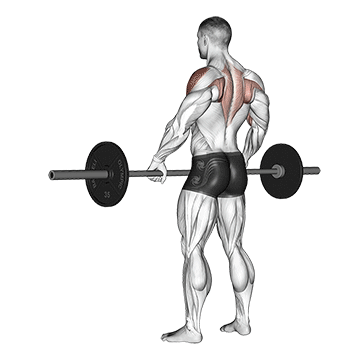Exercise details
- Target muscle: Lateral Deltoid
- Synergists: Anterior Deltoid, Supraspinatus, Brachialis, Brachioradialis, Biceps Brachii, Middle and Lower Trapezius, Serratus Anterior, Infraspinatus, Teres Minor
- Mechanics: Compound
- Force: Pull
Starting position
- Stand upright holding a barbell with a shoulder-width, overhand (pronated) grip. The bar should be resting on the front of your thighs.
- Pull your shoulders back and stick your chest out.
Execution
- Exhale as you pull the bar up towards your chin, making sure to stop when the bar is level with your lower or middle chest. Do not pull the bar any higher.
- Hold for a count of two.
- Inhale as you lower the bar to the starting position.
- Repeat for the recommended number of repetitions.
Comments and tips
- If performed in a certain way, this exercise can lead to shoulder damage in some people. See “Concerns” below.
- Keep the barbell close to your body.
- Keep your body upright, your shoulders back, and your chest out.
Upright row concerns
The upright row can be performed with a wide grip (as described above) or a narrow grip. The exercise, especially the narrow-grip upright row, has come under a lot of scrutiny because it can apparently harm your shoulders. Many trainers recommend that you avoid the exercise altogether, while others say that the wide-grip upright row, if performed in the way described above, is safe.
The problem with the popular narrow-grip upright row is that it requires that you pull the bar above shoulder level with your arms in an internally rotated position, which can cause shoulder impingement. More specifically, what could happen is that every time you raise the bar, a small tendon in your shoulder can get pinched (impinged) by the bones in your shoulder joint. Gradually, the tendon can become worn down to the point where it could even snap—and you may not even be aware that the tendon was getting damaged!
However, the risk of shoulder impingement can be reduced if you do as described above and use a wide grip, keep your shoulders back, keep your chest out, keep the bar close to your body, and pull the bar no higher than the level of your lower or middle chest.
You can reduce risk even further by:
- avoiding super-heavy weights
- practising strict form
- adding resistance slowly
- warming up thoroughly before you perform the exercise.
If at any time you start to feel pain, stop using the exercise and stick with the very few other exercises that target your lateral deltoid (Y-raise, dumbbell armpit row, and dumbbell lateral raise).
















